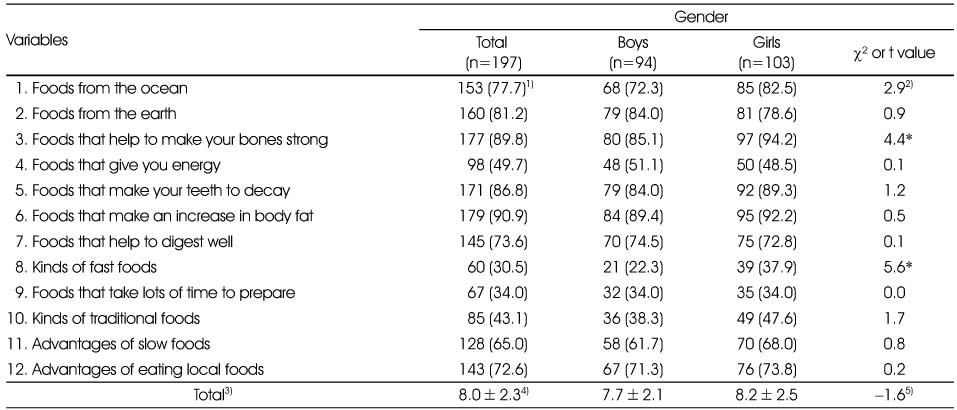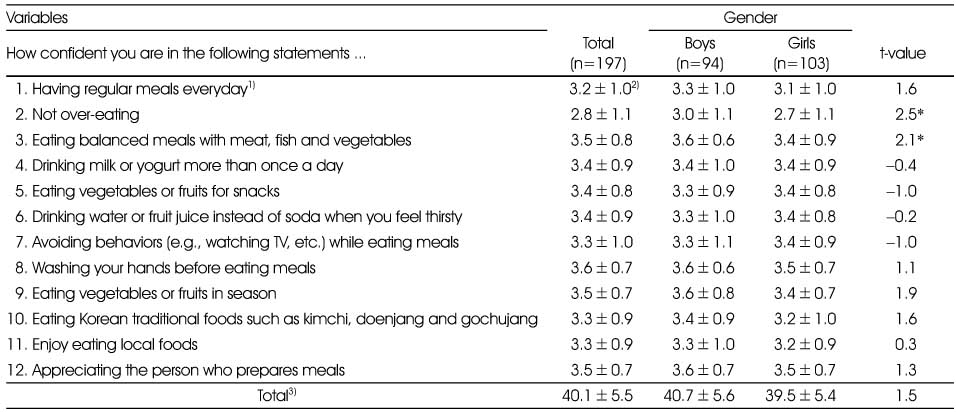References
1. Koo JO, Kim JH, Byun KW, Sohn CM, Lee JW, Lee JH, et al. Nutrition through the life cycle Goyang: Powerbook; 2011. p. 175–201.
2. Mascola A, Bryson S, Agras W. Picky eating during childhood: A longitudinal study to age 11 years. Eat Behav 2010;11(4):253–257.
3. Ministry of Health and Welfare, Korea Centers for Disease Control and Prevention. Korea National Health and Nutrition Examination Survey (KNHANES VI-2) [Internet] 2015. cited 2016 Jan 25. Available from:
http://knhanes.cdc.go.kr/.
4. Lee JY, Cho DS. The eating behavior and food preference of preschool children in Sungnam day care facilities. Korean J Food Nutr 2006;19(4):482–495.
5. Schindler J, Corbett D, Forestell C. Assessing the effect of food exposure on children's identification and acceptance of fruit and vegetables. Eat Behav 2013;14(1):53–56.
6. Lee MS, Lee KH. Development and application of dietary education to improve the vegetable intake of preschoolers. J Korean Diet Assoc 2014;20(1):26–35.
7. Yang HJ. Slow food movement. Food Sci Ind 2011;44(4):68–72.
8. Woo T, Lee KH. Development of a sensory education textbook and teaching guidebook for preference improvement toward traditional Korean foods in schoolchildren. Korean J Nutr 2011;44(4):303–311.
9. Anderson ES, Winett RA, Wojcik JR. Self-regulation, selfefficacy, outcome expectations, and social support: Social cognitive theory and nutrition behavior. Ann Behav Med 2007;34(3):304–312.
10. Lee SB, Jeong YR, Ahn HJ, Ahn MJ, Ryu SA, Kang NE. The development of a nutrition education program for lowincome family children by applying the social cognitive theory and health belief model. Korean J Community Nutr 2015;20(3):165–177.
11. Kwak S, Woo T, Lee KA, Lee KH. A comparison of dietary habits and influencing factors for vegetable preferences of adolescents in Gyeongnam province. Korean J Community Nutr 2015;20(4):259–272.
12. Na SY, Ko SY, Eom SH, Kim KW. Intakes and beliefs of vegetables and fruits, self-efficacy, nutrition knowledge, eating behavior of elementary school students in Kyunggi Area. Korean J Community Nutr 2010;15(3):329–341.
13. Kim JH, Kim YS, Kim Y, Kang MS. Fruit and vegetable consumption and factors affecting fruit and vegetable consumption of school children and adolescents: Findings from focus-group interviews with school nutrition teachers and nutritionists. Korean J Community Living Sci 2013;24(4):567–581.
14. Oh SM, Yu YL, Choi HI, Kim KW. Implementation and evaluation of nutrition education programs focusing on increasing vegetables, fruits and dairy foods consumption for preschool children. Korean J Community Nutr 2012;17(5):517–529.
15. Kim YS, Lee MJ. Effects of nutrition education through social cognitive theory in elementary school students -Focusing on the nutrition education of sugar intake-. Korean J Food Nutr 2011;24(2):246–257.
16. Chung H, Eum YH. A study on the children's eating habits and food preference according to their parents' economic status (II) -Seoul & Gyeonggi (Incheon) area -. Korean J Nutr 2008;41(1):89–99.
17. Hong MA, Choi MS, Han YH, Hyun TS. Effect of nutrition education program developed by a public health center on preschool children's nutrition knowledge and dietary habits and the parent's dietary attitudes. Korean J Community Nutr 2010;15(5):593–602.
18. Park YM, Ahn YK. The relationship between teacher's and parent's nutrition knowledge, food habit, diet-guidance for early childhood and children's nutrition knowledge, foodhabit. Wonkwang J Humanit 2012;13(1):67–91.
19. Pyo SH, Kang HJ. A study on the actual state of nutrition knowledge, dietary attitude, eating behavior, physical ability and locomotion of children aged 5 years in Siheung-city. Korean J Food Nutr 2014;27(5):760–770.
20. Lee OH, Chang SO, Park MJ. Comparison of nutrition knowledge, dietary attitude and dietary habit in elementary school children with and without nutrition education. J Korean Soc Food Sci Nutr 2008;37(11):1427–1434.
21. Kwon DH, Han SN, Kim HK. Evaluation of a nutrition education program for 3rd grade elementary school students. Korean J Community Nutr 2011;16(2):183–194.
22. Kawak SH. Analysis of self efficacy, dietary efficacy and exercise efficacy depending on gender type of the elementary school students [master's thesis] Sangji University; 2009.
23. Park KE, Kim SH. Effects of stress on food habits, preference and frequency in young children at Kyungbuk area. J East Asian Soc Diet Life 2007;17(2):164–182.
24. Seo JY, Lee IS, Choi BS. Study of food intakes and eating patterns among preschool children in Daegu area - Nutrient intakes and dietary habits associated with body weight status -. Korean J Community Nutr 2009;14(6):710–721.
25. Moon HK, Min JH, Kim JN. Monitoring diet and health related content in terrestrial TV programs for young children. Korean J Health Educ Promot 2010;27(3):85–96.
26. Baranowski T, Diep C, Baranowski J. Influences on children's dietary behavior, and innovative attempts to change it. Ann Nutr Metab 2013;62suppl 3. :38–46.
27. Paik ES. The relationship between children's self-regulation and dietary life and dietary behavior [master's thesis] Ajou University; 2010.
28. Cerin E, Barnett A, Baranowski T. Testing theories of dietary behavior change in youth using the mediating variable model with intervention programs. J Nutr Educ Behav 2009;41(5):309–318.
29. Seo SJ, Min IJ, Shin HS. Study of eating behavior and food preference in young children: Differences by age and gender. J East Asian Soc Diet Life 2009;19(5):659–667.
30. Kim HK, Kim JH. A preliminary study on nutrition education for preschool children in day-care center - Dietary habit and nutrition knowledge -. J Korean Soc Food Sci Nutr 2006;35(7):866–873.






